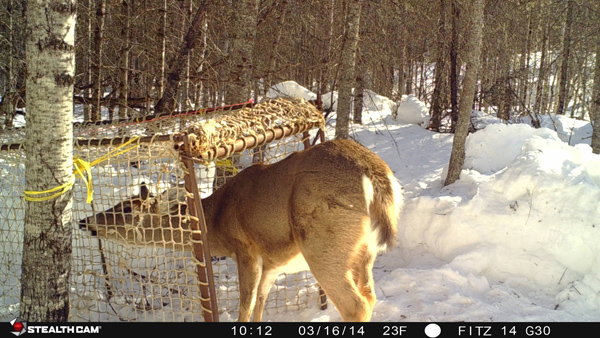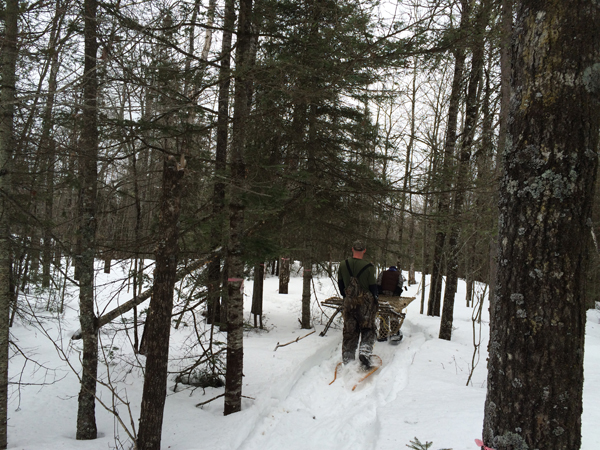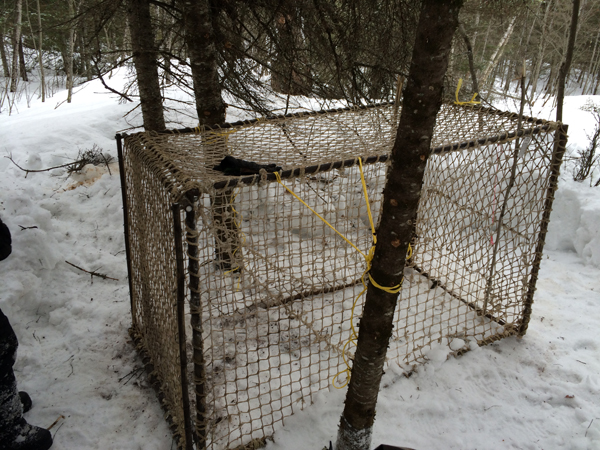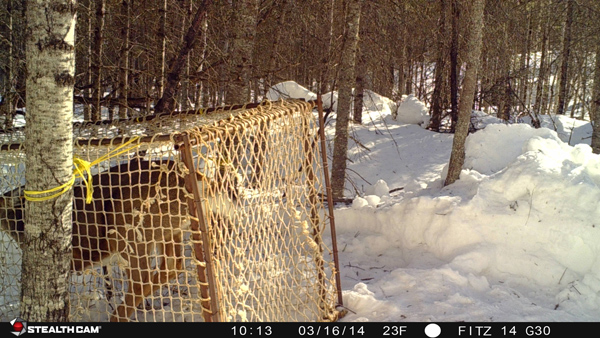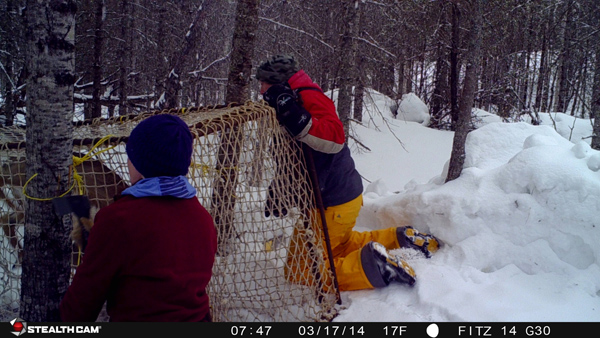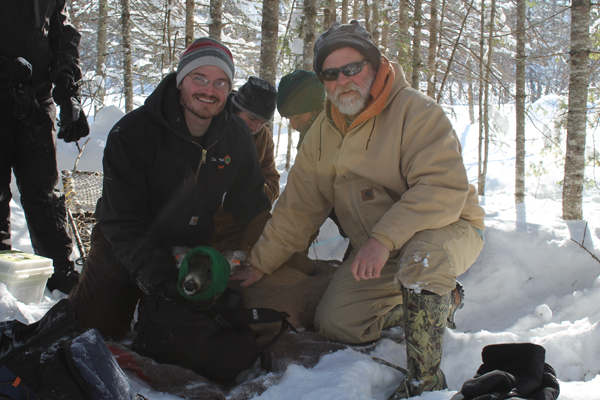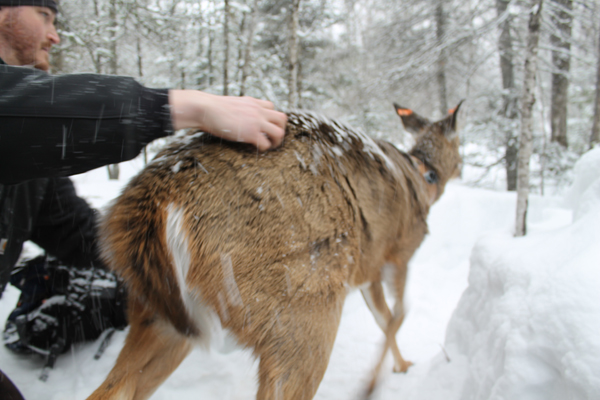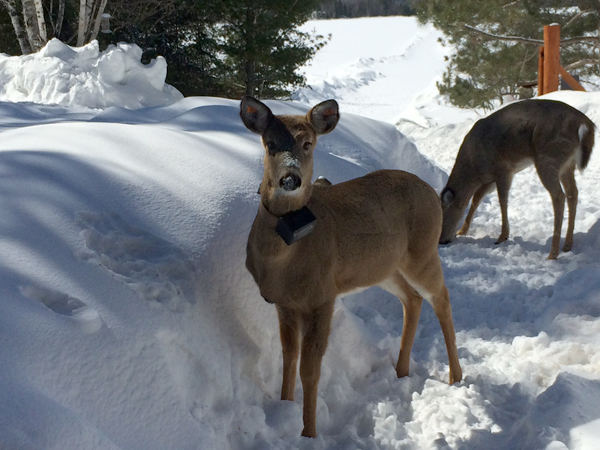LAST UPDATED: May 1st, 2015
Story submitted by Mike Fitzgerald
I never thought the sound of hatchets striking two trees in the woods some 90 yards off would bring such excitement. I turned to the scientist behind me and pumped my fist as if I had just scored a goal in a Stanley Cup Playoff game. Through his grinning teeth he whispered, “Sounds like we got one.” He pulled up his sleeve to check his watch. “We’ll give them five minutes and slowly work our way in.”
The trapping process and action was captured by the new Stealth Cam G Series trail camera.
Of Moose and Deer
The moose population in northern Minnesota has been on the decline over the past decade. The population has in fact dropped more than 50% since 2006. Starting in 2012, the Minnesota DNR indefinitely closed the moose hunt for the state. They also launched a 1.2 million dollar moose mortality study to try and indentify the cause of these drastic declines.
Many wildlife biologists believe the milder and shorter winters of the late 2000s and early 2010s may have been detrimental to moose for a couple different reasons. First, warmer temps not only cause moose high levels of stress in the summer as they try and keep their massive bodies cool, but milder winters also allow more ticks and other parasites to survive in the warm bodies of moose.
Secondly, warmer temperatures have aided in the expansion of whitetail deer populations in the area. Whitetails not only can complete for food sources, but they also carry and transmit brain worms and liver flukes which can be more harmful to their larger cervid cousins, moose.
Getting Involved
In early March of this year, I stumbled upon an article in our local newspaper about the moose study. The article indicated plans to trap and GPS collar whitetails in some of the areas where moose had been collared the previous winter. One of the areas listed was Mitchell Lake, the lake where my wife, father, step-mother and I live. After some routing around, we were put in touch with Amanda McGraw, the PhD student at the University of Minnesota Duluth who was leading the whitetail portion of the study.
The purpose of this study is to provide information about how deer and moose interact on the landscape to better understand the potential for competition for food as well as to determine how moose may be coming into contact with parasites carried by deer. Data collected from the GPS collars on deer will be used to improve understanding of how much of a role deer are playing in the moose population decline. Findings from this project will be helpful to wildlife and land managers as they restore certain parts of the landscape for moose. This project is a collaborative effort involving University of Minnesota Natural Resource Research Institute (NRRI), Minnesota Zoo, and Minnesota Department of Natural Resources. Significant contributions have also been made to the project by 1854 Treaty Authority and Fond du Lac Band of Lake Superior Chippewa.
McGraw and her team were in process of scouting locations throughout the area to trap a number of deer. Sixteen whitetails were collared already in the Isabella area prior to their move closer to Ely, MN. After talking with McGraw, my dad and I quickly volunteered to help anyway possible, including offering access to our adjoining properties for setting traps. McGraw decided that Mitchell Lake would join two other areas as locations where their trap-lines would be set.
Setting Traps
The first afternoon McGraw and her crew arrived they brought only a couple traps to set. We spent most of the time walking the resort property that my wife and I run. I tried best I could to explain how I believe the deer to move along our ridge. In the end we found two locations that looked ideal for setting traps and we had enough time to actually set one up. On day two, five more traps were set including two on my father’s neighboring property.
Carrying in these deer traps through several feel of Minnesota snow is no easy task. Snowshoes are a must.
The traps being used were Clover Traps from the MN DNR. This trap design was first developed in the 1950s and has remained mostly unchanged ever since. Essentially the trap is a collapsible box frame made of metal pipe that has netting for the top, sides and door. The trap is anchored into the ground with metal spikes and then held upright by tying the sides off to a nearby tree on either side.
Once armed, the door is held open by a nail and string that is pinched in the jaws of a closed mouse trap. The trip wire is then ran across the back of the trap and hooked to the jaw of the mouse trap. After being baited, a deer will enter the trap and feed on the bait in the back of the trap. Once the wire is tripped, opening the jaw of the mousetrap, the string holding the nail in place is loosed and the door shuts behind the deer.
A full trap set and ready to go.
Once the deer enters the trap is sprung, allowing the soft netting to close the cage while preventing the deer from harming itself accidentally.
The soft sided nature of these traps not only helps keep the deer from injuring itself, but also aids in the expedient immobilization and sedation of trapped deer. Two biologists run down the trail to the trap as quietly and quickly as they can. If a deer is in the trap, they sprint to its sides and cut the twine with hatchets. Once they cut the twine, the trap can be collapsed onto the deer, pinning it down with the netting and their body weight. Once pinned, a biologist injects the deer with a sedative.
After collapsing the trap scientists immobilize the deer while sedating it.
After injection, the two biologists keep the deer pinned and immobilized without saying a word. The rest of the crew remains waiting in the distance to prevent further panicking the deer. Adrenalin can fight against the sedatives so they want to keep the deer as calm as possible. Once the drugs have taken effect, the rest of the team moves in to help process the deer.
Back to the Story
As I neared the site, I could see McGraw and her assistant kneeling on either side of the collapsed trap. Once there, the trap door was opened and the trap was partially raised allowing access to the deer. A hood was placed over this doe fawns head and she was gingerly pulled from the trap and placed on a blanket nearby. Now it was time to get to work.
Blood, hair and fecal samples were taken. If necessary, tooth samples would be taken for aging. However, in this case, the tiny fawn’s age was not in question. A number of body measurements were taken including body length and neck girth. Respiration and body temps were also recorded every few minutes. Next came ear tags, one in each ear, and the fitting of the collar. A fawn like this one gets a collar with added foam allowing for future growth of its neck without being so loose that she would be able to remove collar on her own.
This amazing experience was made even better because I was able to share it with my father.
After all this was done and recorded, the deer was given shots with antibiotics and vitamin D to aid in her recovery from the stress of the capture. Finally, a reversal drug was administered to bring her out of sedation quickly. The crew remained on site until the she regained enough strength and composure. Then we watched as she walked back into the woods under her own power.
After regaining her strength the newly tagged doe was able to make her way back into the forest under her own power.
I named that little doe fawn Pip. She would be joined over the next week and a half by three other deer collared from the six traps set on our Mitchell Lake properties. One of those deer was another doe fawn (Squeak) and two were adult does (Patty who was caught on March 17th, and Jane). Twelve additional deer were caught, collared and tagged between the other two trapping locations near Ely. Combined with the deer in the Isabella area, this brought the total number of deer in the study to 32.
The deer in this study will dawn their collars for two years, after which the collars will be removed automatically by a radio signal and release mechanisms built into their collars. In the mean time their location is sent every two hours to McGraw and her crew. This information will then be overlaid with locations from the moose involved in the study.
As an avid bow hunter and nature lover, this whole study has fascinated me from its beginning two years ago. Being able to then become a part of it and its inclusion of whitetail was absolutely incredible. I’m excited to follow along as researchers try and pinpoint what is happening to Minnesota’s moose populations. I’m equally excited to follow my 4 does as they age over the next couple years and into the future. With their ear tags, I should be able to identify these does for many years after this study completes.
Radio collars and ear tags will make these deer easy to recognize.
For more information on the moose study, check out the following links:
Minnesota Department of Natural Resources
What is Killing Minnesota Moose?

